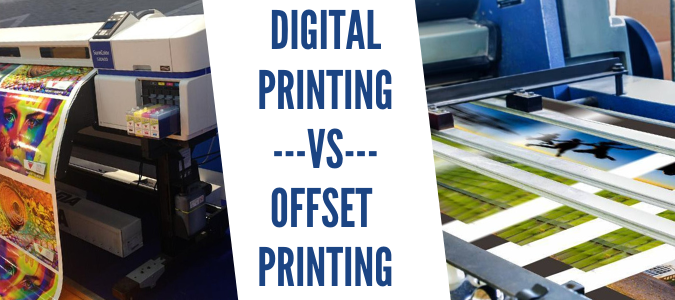
Offset Printing Vs Digital Printing
The need for printing is an integral part of almost every organization today. Woodcut is the oldest printing technique ever used and different techniques have been developed and evolved over the years since then. Offset printing and digital printing are widely used printing techniques and each one comes with their own set of advantages and disadvantages.
What is Offset Printing?
It is a printing technique that uses a plate to transfer the inked image to a rubber cylinder which is then offset to the printing material. The printing material may be paper, cloth, leather, etc.
What is Digital Printing?
It is a printing technique that uses different printers such as laser, inkjet printers, etc. to print the content from digital sources directly to the paper or other media. It facilitates on-demand printing with a shorter turnaround time.
Let’s take a comparative look of offset printing Vs digital printing in terms of different parameters OR we can advantages and disadvantages of digital printing & offset printing:
- Cost-effectiveness: Offset printing is recommended if you need to print in large volumes, nearly 1000 or above that. Since offset printing involves high setup costs, it is cost-effective for large volumes and costlier for low-volume printing. Digital printing is relatively cheaper when you have to print limited volumes, say less than 1000 pieces as there are no set-up costs involved. Offset printing is generally preferred for printing large volumes of magazines, newspapers, or brochures whereas digital printing is suitable for low-volume invitations, business cards, etc.
- Turnaround Time: The printing time is shorter in case of digital printing since there is no set-up involved. For Offset printing, the necessary plates are to be created before the printing begins and hence it has a longer turnaround time. Also, in case of any errors or mistakes on the plate, it is difficult to fix it and the plate creation has to be done all over again. This may add up to even more output time.
- Print and Color Quality: In the case of offset printing, the image quality and the color balance is superior since it has the advantage of mixing custom inks for each print job. Though the image quality is good in digital printing, it uses standard digital printing ink colors and hence cannot always match the required colors. For precise colors, you must opt for offset printing.
- Variable Print Data: Altering the print data within a single batch print is possible with digital printing. For example: if you wish to print invitations for an event for two separate dates, it is possible to get two sets printed with different dates within the same batch. This variation of data is not possible with offset printing.
- Printing Material: Offset printing can accommodate a variety of print media whereas digital printing can be done on a limited variety of materials.
Choose the Technique that Suits your Requirements:
Before choosing the printing technique, you must analyze the number of pieces to be printed, the requirement of color precision, how much time do you have to get the job done, the material to be used for printing and any variable print data requirements. Based on these, you may choose offset printing or digital printing techniques.
To explore your printing options for offset printing or digital printing, please contact us today!




